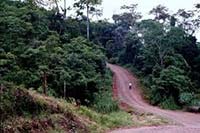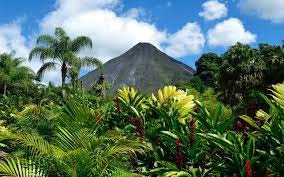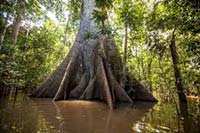Saturday, 18 October 2025

The University of the Third Age meeting report
Jungle Look – The Birds and the Bees and the Kapok Tree
Speaker: Chris Freeman
The guest speaker at the Annual General Meeting of u3a Todmorden on 16th of October 2025 was Chris Freeman with: "Jungle Look – The Birds and the Bees and the Kapok Tree'.
Chris has been a speaker for over forty years and regularly visits groups and other audiences on behalf of the charity 'Water Aid'. On one of his recent talks to a number of schools online, he had an audience of over four thousand children.
Chris's wife mentioned that she would like to visit a rain forest, so a trip to one in the Americas was arranged. They travelled to Costa Rica via a stop off in New York City, which we know is called the 'Big Apple'. The city was given this name by tramps, or street people, as they are called these days, because they think of all cities as an apple.
Chris went on to tell us more about some of the places, and people that we recognise as being from, or in that city. One of these was Grand Central Terminal which, though not completed, opened on Sunday, February 2, 1913. Because of the natural foundations of granite, the driving force and owner of this project, Cornelious Vanderbilt, was able to build a skyscraper on the same site. The station combines the trains of the New York Central & Hudson River, New York and Harlem, and New Haven railroads.
Chris showed other images from the city, including street performers, traffic, and a street in Central Park South that receives zero sunshine on every day of the year.
They left New York to fly down to Costa Rica, Chris wanting to see Volcanoes, his wife looking forward to the rain forest. There were no standard itineraries, but they eventually put one together with the help of someone in the area.
 They would travel around the country in a small van, or minibus driven by local drivers. The drivers competed for the job, one of the reasons being to improve their English language, as well as their wages. Chris showed a slide showing the dirt roads they would travel on. There would be no tarmacked roads as Costa Rica was particular in the preferred choice of tourists - interested in both the country and in small groups - no large or heavy vehicles. Their accommodation was very simple – stone walls with no windows, and thick roofs to keep the inside cool.
They would travel around the country in a small van, or minibus driven by local drivers. The drivers competed for the job, one of the reasons being to improve their English language, as well as their wages. Chris showed a slide showing the dirt roads they would travel on. There would be no tarmacked roads as Costa Rica was particular in the preferred choice of tourists - interested in both the country and in small groups - no large or heavy vehicles. Their accommodation was very simple – stone walls with no windows, and thick roofs to keep the inside cool.

One morning when Chris was making coffee, he heard a bang, which came from a volcano from the Pacific Ocean to their right. A few minutes later he heard another bang, but this time coming from their left - the Atlantic Ocean. It was the same volcano; but the winds that swirl around it cause that effect. Chris could actually see the top of the volcano, which had been covered in clouds for about three months before that.
They travelled along a river in one of two boats along with a party in the other. The local guides in each boat were a Botanist and a Geologist who both earned more money than they could working in their own specialities. They were booked up for a number of months ahead, and were employed by the government.
The rubber boats were specially made to deal with the rocks and other debris. The boats were not fully inflated, and the bottoms of them were made of extra tough materials.
 A Kapok Tree had fallen into the river, and had to be avoided by either going round, or lifting the boat above it. The law in Costa Rica is that it would stay where it fell, until moved by the river itself. Rivers are never diverted or re-routed unless it is caused by the weather or other natural events. There is a local saying, along the lines of 'where the river wants to go, it goes'. A Kapok tree can weigh as much as twenty tons, or double that weight, when it is wet. Its wide canopy is often the cause of it collapsing.
A Kapok Tree had fallen into the river, and had to be avoided by either going round, or lifting the boat above it. The law in Costa Rica is that it would stay where it fell, until moved by the river itself. Rivers are never diverted or re-routed unless it is caused by the weather or other natural events. There is a local saying, along the lines of 'where the river wants to go, it goes'. A Kapok tree can weigh as much as twenty tons, or double that weight, when it is wet. Its wide canopy is often the cause of it collapsing.
Chris showed another image, this one of a 'Monkey Gap'. In Costa Rica, it most likely is related to the "monkey bridges" or canopy crossings built to help monkeys and other wildlife to safely cross gaps in the forest, for example those made by roads or rivers. It could also refer to specific locations where monkeys are known to be visible. We saw a picture of a slower animal from the forests; the Sloth – an animal with no predators and can swim much faster than it can walk, which might have caused its fur to turn green. Two thousand species of mammals exist in the forest, and about half of them can fly.
Turning to his own interest on the trip, Chris told us about features of volcanoes, starting with Lava bombs, also known as volcanic bombs. These are large masses of molten rock (each piece 64 mm or 2.5 inches in diameter) ejected from a volcano during an eruption, that cool and harden as they fly through the air. While they may start as round blobs, high-speed footage shows that larger bombs can change shape mid-flight into irregular forms, impacting their flight paths and creating a significant hazard during volcanic eruptions.
He showed slides of lava bombs, pictured while rolling down the slope of a volcano, getting smaller on their journey. These are classed in volcanology as a Strombolian eruption, a type of volcanic eruption with relatively mild blasts. Strombolian eruptions consist of ejection of incandescent cinders, lapilli, and volcanic bombs, to altitudes of tens to a few hundreds of metres. An image of the volcano when it was erupting showed that the lava was actually coming out of the side of it. The lava subsequently formed into a mass, similar to a field which is almost, if not impossible, to cross. Hot springs are also created through these eruptions.
There is no exact number for the total of hot springs tapped in Costa Rica, but there are at least 14 in the Arenal region alone, with many more located throughout the country near volcanic areas. The ones that are tapped contribute to the production of electricity in the country.
A much more friendly environment can be found in Monteverde, which is a world-renowned ecotourism destination. It is famous for its lush and misty cloud forests. The cooler, high-altitude climate supports incredible biodiversity, making it a haven for nature lovers and adventure seekers.
The country is also noted for its count of around 1400 orchid species. While a profusion of orchids in the mountainous, wetter areas of the country, the seasonally dry, deciduous forests on the Nicoya Peninsula presents less, and a lower diversity of, orchid species.
Chris also visited Monteverde using the 'A' road, showing an image of it which was similar to what we would call a track. The hotel that he stayed in at Monte Verde was, not surprisingly by now, very different from our country. The rooms were on different levels and there is often a walk between, to navigate the paths up and down.
His presentation today lasted over an hour, and was full of information and humour, much appreciated by our members.
Not yet a member? We're always delighted to welcome new members. Contact details: website at www.u3atod.org.uk or email at info@u3atod.org.uk.
Many thanks to Colin Sanson for this report
Previous U3A reports on the HebWeb - click here

